Italian cassata is a delightful dessert that beautifully captures the essence of Sicily. Originating in Palermo, this traditional cake boasts layers of ricotta cheese, candied fruit, and a hint of liqueur, all encased in a sponge cake and often topped with marzipan. It’s a true celebration of flavors and textures that have been perfected over centuries.
What is Cassata Cake?
Cassata cake, a Sicilian masterpiece, is a layered dessert that captures the essence of Italian flavors. Originating in Palermo, it layers a ricotta cheese filling between slices of sponge cake soaked in liqueur. What sets cassata apart is the inclusion of candied fruits, adding a delightful sweetness and vibrant color to each bite.
The base of the cassata cake is a light, airy sponge cake that serves as the perfect canvas for the rich, creamy ricotta layer. The ricotta is often sweetened with sugar and mixed with chocolate chips or more candied fruit, enhancing its luscious texture. This cake is then assembled by alternating layers of sponge cake and ricotta mixture, building a tower of indulgence.
Once assembled, the cassata cake is usually covered with a layer of bright green marzipan, adding an almond-flavored sweetness and smooth finish. Some variations also include a thin layer of icing or a glaze adorned with more candied fruit on top, creating an eye-catching presentation.
Embodying a fusion of cultures and flavors, cassata cake is a testament to the rich culinary history of Sicily. The combination of the creamy ricotta, moist sponge cake, and sweet candied fruit creates a multi-sensory experience that is both satisfying and unforgettable. With each bite, you’re tasting a piece of Sicily’s heritage and the centuries of tradition that went into perfecting this exquisite dessert.
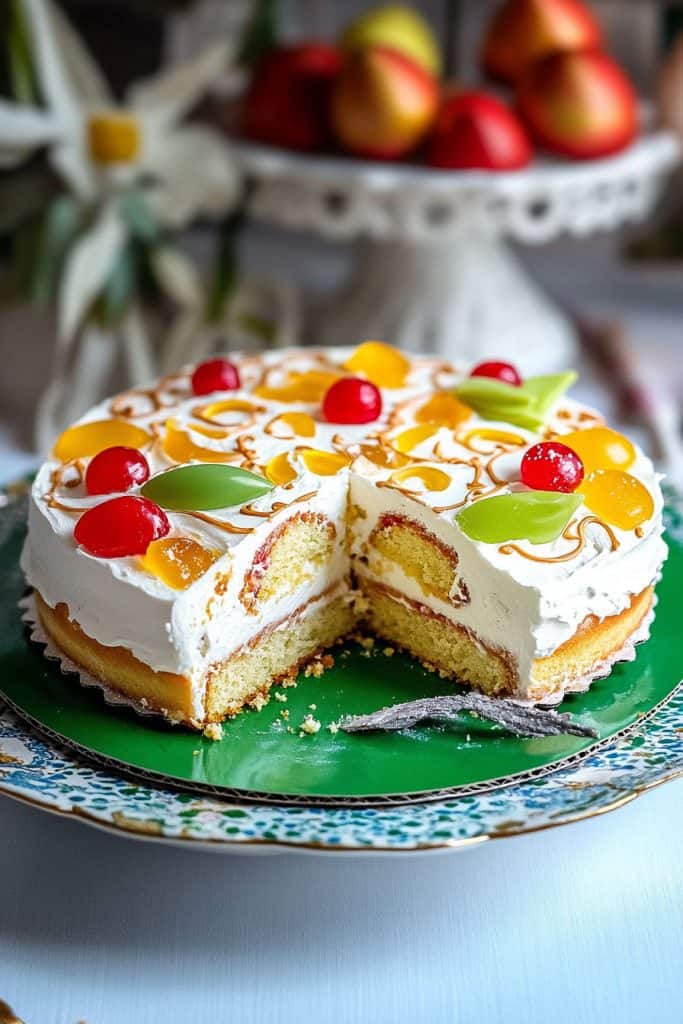
Types of Cassata Cake
Italian cassata is a diverse dessert with variations that reflect regional influences and personal preferences. Let me take you through some popular types of cassata cake that you can explore and enjoy.
Traditional Sicilian Cassata
The Traditional Sicilian Cassata is the most recognized version. It features layers of sponge cake soaked in liqueur—usually Marsala or rum—filled with a mix of sweetened ricotta cheese, candied fruit, and chocolate chips. The exterior is covered in marzipan and decorated with more candied fruit and icing, creating a vibrant and festive look.
Ingredients:
- 1 sponge cake (sliced into layers)
- 1 cup Marsala or rum
- 2 cups ricotta cheese (drained and whipped)
- 1 cup powdered sugar
- 1/2 cup candied fruit (chopped)
- 1/2 cup chocolate chips
- 1/2 cup marzipan
- Additional candied fruit for decoration
- Icing (optional)
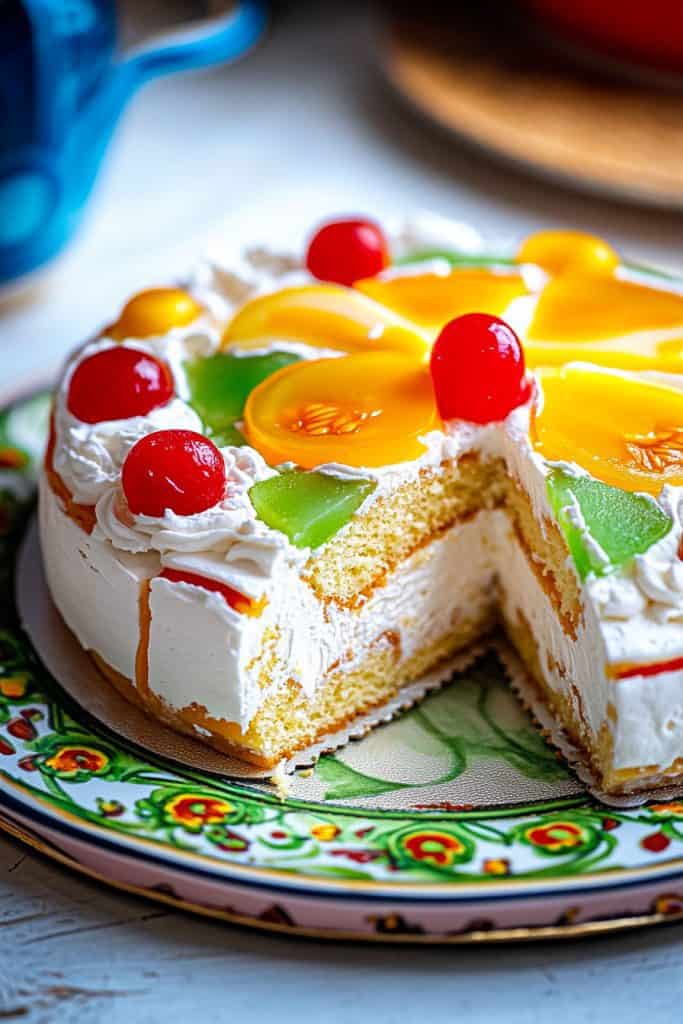
Neapolitan Cassata
The Neapolitan Cassata brings a twist to the traditional recipe with the addition of sponge cake layers flavored with citrus zest. This variation may also include a layer of jam and is typically adorned with a dusting of powdered sugar instead of marzipan.
Ingredients:
- 1 sponge cake (sliced into layers)
- 1 cup citrus liqueur (such as Limoncello)
- Zest of 1 lemon and 1 orange
- 2 cups ricotta cheese (drained and whipped)
- 1 cup powdered sugar
- 1/2 cup candied fruit (chopped)
- 1/2 cup chocolate chips
- 1/2 cup fruit jam (optional)
- Powdered sugar for dusting
Cassata al Forno
Cassata al Forno is a baked variation of the traditional cassata. Instead of being assembled like a layer cake, the ingredients are encased in a pastry dough and baked until golden. This results in a rich, pie-like dessert with a crusty exterior and a creamy, flavorful filling.
Ingredients:
- Sweet pastry dough (for crust)
- 2 cups ricotta cheese (drained and whipped)
- 1 cup powdered sugar
- 1/2 cup candied fruit (chopped)
- 1/2 cup chocolate chips
- 1/2 cup marzipan
- Additional candied fruit for decoration
Modern Cassata
Modern Cassata recipes showcase contemporary twists on the classic, often incorporating different flavors and ingredients such as pistachio paste, mascarpone cheese, or even gelato. The focus is on innovation while still honoring the cassata’s rich tradition.
- 1 sponge cake (sliced into layers)
- 1 cup flavored liqueur of choice
- 2 cups ricotta cheese or mascarpone (or a combination)
- 1 cup powdered sugar
- 1/2 cup pistachio paste (optional)
- 1/2 cup candied fruit (chopped)
- 1/2 cup chocolate chips or other mix-ins
- Gelato (optional)
- Marzipan or icing (for decoration)
These variations of cassata cake illustrate the versatility and enduring appeal of this beloved Italian dessert. Whether you prefer the classic, enjoy regional twists, or like modern takes, there’s a cassata cake to suit every palate.
Ingredients for Italian Cassata
Crafting a traditional Italian Cassata requires a variety of specific ingredients for each layer. Let’s break it down into the key components.
Cake Ingredients
- 1 1/4 cups of all-purpose flour
- 1 cup of granulated sugar
- 4 large eggs, at room temperature
- 1/4 cup of whole milk, at room temperature
- 1/4 cup of unsalted butter, melted and cooled
- 1 teaspoon of baking powder
- 1 teaspoon of vanilla extract
- Zest of 1 lemon
- Pinch of salt
Ricotta Filling Ingredients
- 2 cups of fresh ricotta cheese, drained
- 3/4 cup of powdered sugar
- 1 teaspoon of vanilla extract
- 1/4 teaspoon of ground cinnamon (optional)
- 1/2 cup of mini chocolate chips
- 1/2 cup of chopped candied citrus peel
Marzipan Coating Ingredients
- 1 1/2 cups of almond flour
- 1 1/2 cups of powdered sugar
- 1 large egg white
- 1/2 teaspoon of almond extract
- Food coloring (optional, typically green)
- 1/2 cup of candied cherries, halved
- 1/2 cup of candied orange slices
- 1/4 cup of candied lemon peel
- 1/4 cup of candied citron peel
Tools and Equipment
Creating the perfect Italian Cassata requires some essential tools and equipment. Having these items ready before you start will streamline the process and ensure a smooth baking experience.
Baking Tools
- Springform Pan: I recommend a 9-inch round springform pan for easy removal of the layered cake.
- Mixing Bowls: Use a set of mixing bowls in various sizes for blending ingredients, whisking, and holding prepared components.
- Whisk: A handheld whisk is essential for beating eggs or combining dry and wet ingredients.
- Electric Mixer: An electric mixer will save time and effort when mixing the sponge cake batter and the ricotta filling.
Preparation and Baking Equipment
- Spatula: Use a rubber spatula for folding ingredients and scraping down mixing bowls.
- Offset Spatula: An offset spatula is particularly useful for spreading layers evenly and smoothly.
- Pastry Brush: A pastry brush is needed for soaking the sponge cake with liqueur or syrup.
- Measuring Cups and Spoons: Accurate measurements are crucial. Ensure you have a complete set of both dry and liquid measuring tools.
- Mesh Sieve: A fine mesh sieve is used for sifting flour and confectioners’ sugar to remove lumps and aerate ingredients.
- Cake Leveler: For precise and even layers, a cake leveler will help you cut the sponge cake horizontally.
- Piping Bags: Piping bags with different tips can aid in decorating the cassata with ease and precision.
- Cooling Rack: A cooling rack allows the sponge cake to cool evenly and prevents soggy bottoms.
By gathering these tools and equipment beforehand, crafting the traditional Italian Cassata becomes an enjoyable and hassle-free process. Each tool plays a vital role in ensuring each layer and filling comes together perfectly, yielding an authentic, delectable dessert.
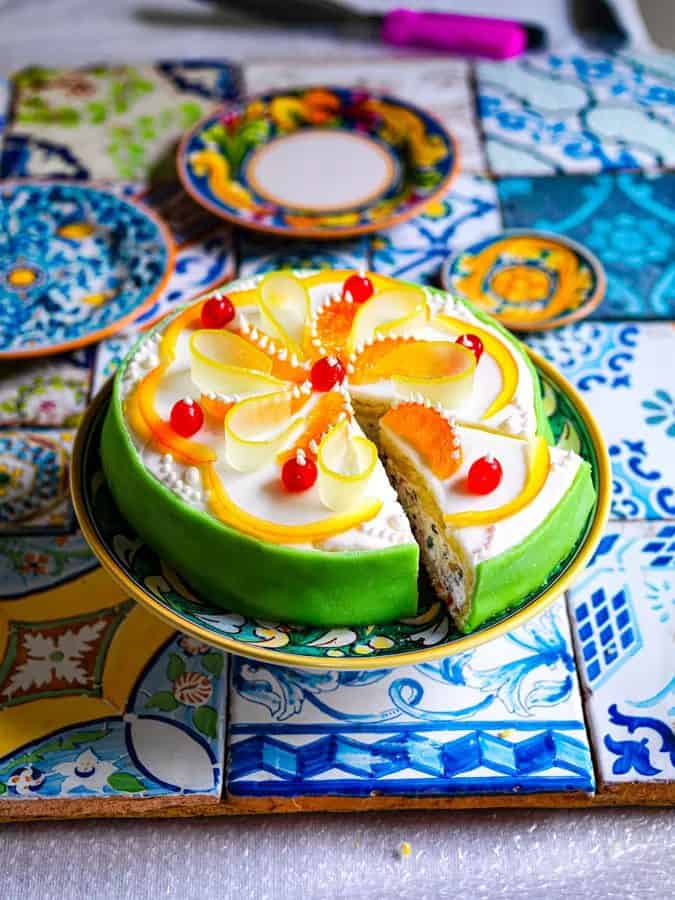
Directions
Crafting an authentic Italian Cassata cake involves several stages, from baking the sponge cake to preparing the ricotta filling and marzipan coating, and finally assembling the layers into a beautiful, traditional dessert.
Make the Cake
- Preheat the Oven: Set your oven to 350°F (175°C). Grease and flour a springform pan.
- Prepare the Batter: In a mixing bowl, combine 1 cup of sugar and 4 large eggs. Beat with an electric mixer on high speed until the mixture is thick and pale, about 5 minutes.
- Add Dry Ingredients: Sift 1 cup of all-purpose flour, 1 teaspoon of baking powder, and a pinch of salt into the wet ingredients. Fold in gently using a spatula until no flour streaks remain.
- Bake: Pour the batter into the prepared pan. Smooth the top with a spatula. Bake for 25-30 minutes or until a toothpick inserted into the center comes out clean.
- Cool the Cake: Remove the cake from the oven and let it cool in the pan for 10 minutes. Transfer to a cooling rack to cool completely.
Prepare the Ricotta Filling
- Drain Ricotta: Place 2 cups of ricotta cheese in a mesh sieve over a bowl. Allow it to drain for at least an hour to remove excess moisture.
- Mix Ingredients: In a mixing bowl, combine the drained ricotta, ½ cup of powdered sugar, and 1 teaspoon of vanilla extract. Mix until smooth.
- Fold in Candied Fruit: Fold in ½ cup of finely chopped candied fruit, including cherries, orange slices, and lemon peel. Ensure the mixture is well-blended.
Prepare the Marzipan Coating
- Roll the Marzipan: On a surface dusted with powdered sugar, roll out 1 pound of marzipan to ¼ inch thickness.
- Cut and Shape: Cut the marzipan into strips long enough to wrap around the cake, and a circle for the top. Keep extra for decoration.
- Prepare Simple Syrup: In a small saucepan, combine ½ cup of sugar and ½ cup of water. Heat until the sugar dissolves. Let it cool slightly.
- Slice the Cake: Use a cake leveler to slice the cake horizontally into three even layers.
- Soak in Liqueur: Brush each layer with the simple syrup mixture and ¼ cup of your chosen liqueur (such as Grand Marnier or Marsala).
- Layer the Ricotta Filling: Place the bottom cake layer on a serving plate. Spread one-third of the ricotta mixture over the layer. Repeat with the second layer.
- Top the Cake: Place the final cake layer on top. Cover the entire cake with the marzipan strips around the sides and the circle on top.
- Decorate: Use any extra marzipan to shape decorative fruits or flowers. Adorn the cake with additional candied fruits if desired.
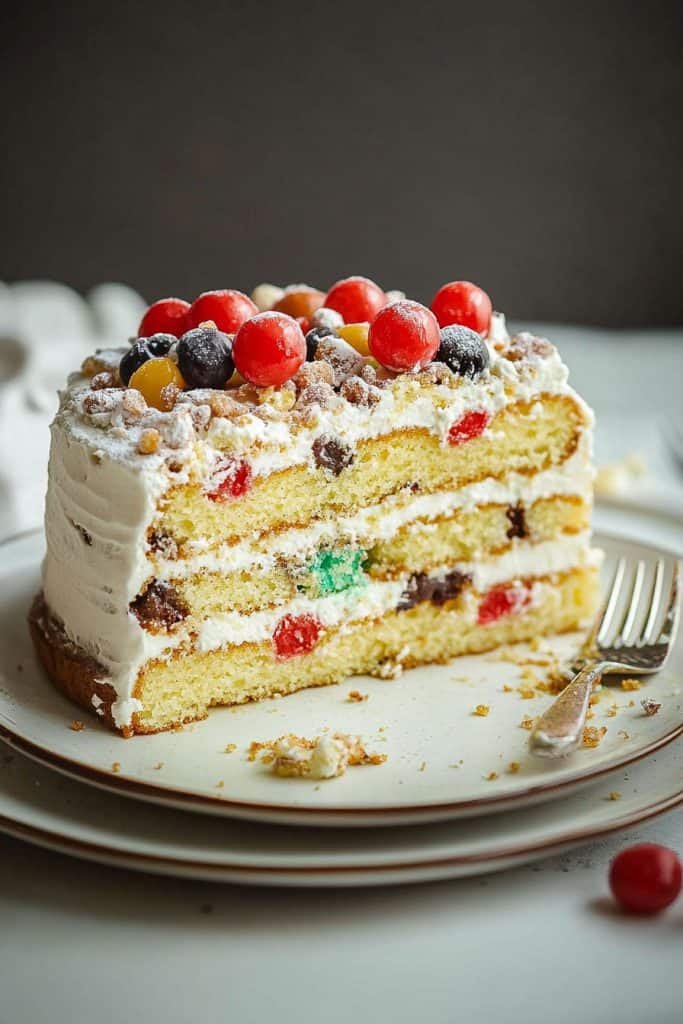
Tips for Perfect Cassata
Choose Fresh Ingredients
Freshness matters most in a cassata. I always start with the freshest ricotta cheese for the filling. Creamy, smooth ricotta enhances the texture and taste of the cake. Likewise, using high-quality candied fruits and fresh almonds for the marzipan will make a noticeable difference in the end product.
Properly Prepare Ricotta
For a velvety filling, I recommend draining the ricotta cheese overnight. Place it in a fine mesh sieve covered with cheesecloth and let it sit in the fridge to remove excess moisture. This step ensures a thick consistency, avoiding a runny filling that could ruin the cake.
Perfect Sponge Cake
The sponge cake foundation must be light and airy. To achieve this, I whisk the eggs and sugar until they double in volume and become pale yellow. Gently folding in the flour without overmixing keeps the batter light. Bake it at 350°F (175°C) until golden brown and a toothpick comes out clean.
Assembling the Layers
Take your time while layering. Evenly spread the ricotta filling between sponge cake layers to avoid overflow. I recommend chilling each layer briefly to help the filling set before adding the next layer. This step also makes it easier to mold the cassata into a uniform shape.
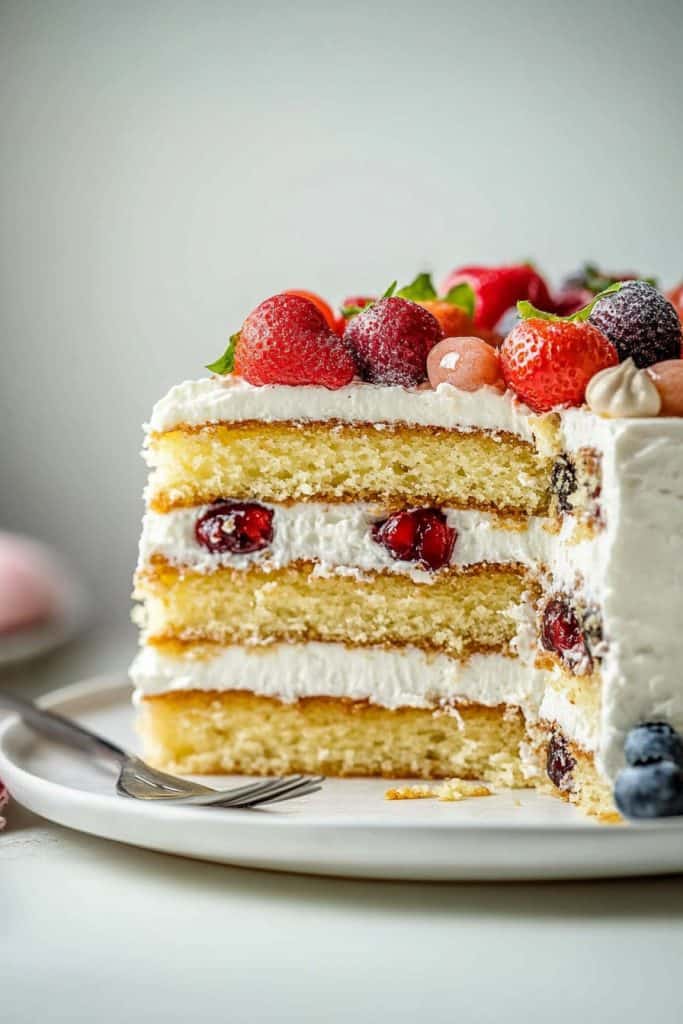
Smooth Marzipan Coating
Working with marzipan can be finicky. Warm it slightly in your hands to make it pliable. Roll it out on a surface dusted with powdered sugar to prevent sticking. Carefully drape it over the assembled cake and smooth it out, pressing gently to adhere it to the ricotta filling.
Chilling Time
Allow the assembled cassata to chill in the refrigerator for at least 4 hours or, preferably, overnight. This resting period allows the flavors to meld and the cake to firm up, making it easier to slice and serve.
Presentation
For a stunning presentation, I garnish the cassata with additional candied fruits and a light dusting of powdered sugar. The colorful fruits provide a charming contrast to the marzipan, making the cake as visually appealing as it is delicious.
Variations of Cassata Cake
Sicilian Cassata
The Sicilian Cassata, the most traditional version, features a ricotta cheese filling mixed with sugar, chocolate chips, and candied fruits. It is encased in a light sponge cake and covered with a layer of marzipan. To add vibrancy and texture, I adorn the cake with more candied fruits and a dusting of powdered sugar.
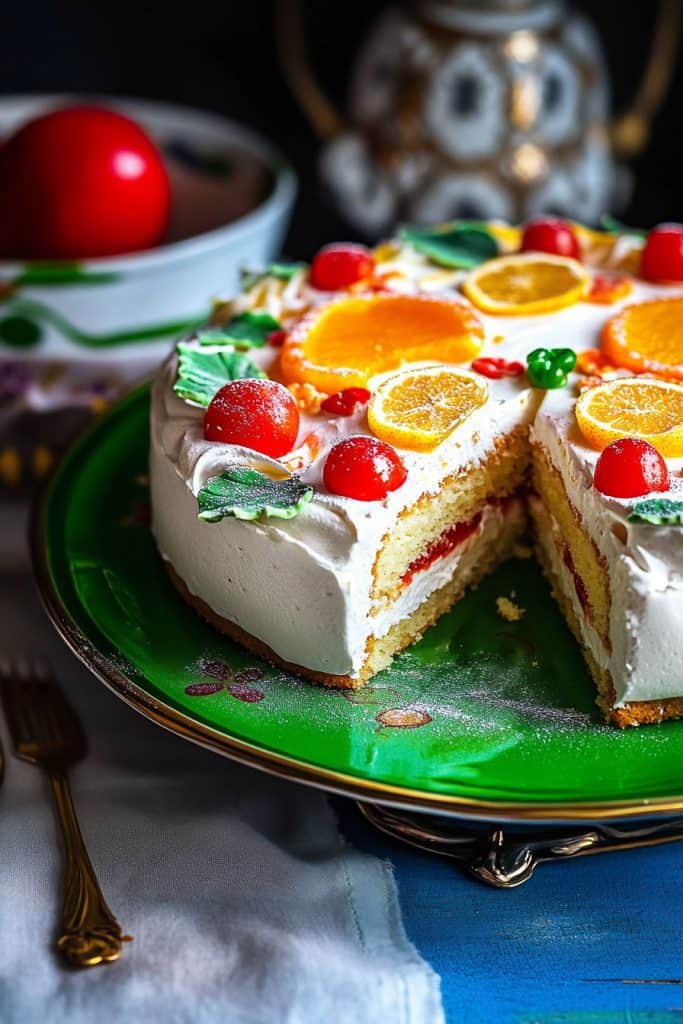
Neapolitan Cassata
Neapolitan Cassata differentiates itself by incorporating a richer variety of nuts and dried fruits. The filling may include hazelnuts, almonds, and sometimes a hint of rum for an extra depth of flavor. Typically, this version uses a chocolate glaze rather than marzipan, giving the cake a more decadent twist.
Cassata Al Forno
Cassata al Forno is a baked version of the cassata cake. Unlike its counterparts, which use sponge cake layers, this variation combines a shortcrust pastry base with the ricotta filling. The cake is baked until the crust is golden and crispy, adding a delightful crunch to each bite. This version is particularly popular during colder months when a warm dessert is preferred.
Cassata Gelata
Cassata Gelata is an ice cream version of the traditional cake, perfect for summer. For this variation, I alternate layers of sponge cake with layers of ricotta ice cream mixed with candied fruits and chocolate chips. The cake is then frozen, creating a refreshing and creamy dessert that combines the best of both worlds.
Modern Fusion Cassata
For a contemporary twist, the Modern Fusion Cassata incorporates international flavors. This version might include matcha, dark chocolate ganache, or tropical fruits such as mango and passion fruit within the layers. I often experiment with these variations to bring a new and exciting element to the classic cassata cake while keeping its essence intact.
Cassata Siciliana Cupcakes
Cassata Siciliana Cupcakes offer a convenient, individual-sized treat. Instead of a large cake, I prepare these by filling cupcake molds with layers of sponge cake and ricotta filling, then topping them with marzipan and a small amount of candied fruit. These cupcakes make cassata more accessible for casual gatherings while still delivering the iconic flavors.
Vegan Cassata
For those who prefer a plant-based diet, Vegan Cassata replaces traditional ricotta cheese with almond or cashew-based alternatives. The sponge cake is made without eggs or dairy, using plant-based milk and flax seeds as binding agents. I ensure the marzipan coating is also vegan, creating a delicious and inclusive version of the classic treat.
Historical Cassata
Historical Cassata pays homage to the original medieval recipes by incorporating ingredients like rose water and exotic spices such as cinnamon and cloves. These unique flavors provide a glimpse into the past while presenting a distinctive and aromatic cake that stands out from contemporary versions.
Each variation of the cassata cake offers a unique twist on the beloved classic, showcasing its versatility and universal appeal. Whether you prefer the traditional Sicilian method or an inventive modern take, cassata cakes provide a delightful and flavorful experience for all occasions.
How to Serve Cassata Cake
Serving cassata cake is an art that can elevate the dining experience. Here are the steps to present this delectable dessert beautifully:
- Chill the Cake: Before serving, make sure the cassata cake is well-chilled. I recommend refrigerating it for at least 4 hours, or overnight if possible. This ensures the flavors meld together perfectly and the cake holds its shape when sliced.
- Prepare the Garnishes: Gather your garnishes. Traditional options include candied fruit, pistachios, and powdered sugar. Arrange these ingredients so you can easily access them when decorating.
- Slice with Care: Use a sharp, serrated knife to cut the cassata cake. Wipe the knife clean between cuts to ensure each slice looks perfect. Aim for slices about 1-inch thick.
- Plate Presentation: Place each slice on a dessert plate. To create a beautiful presentation, dust the plates lightly with powdered sugar before placing the cake slices.
- Add Garnishes: Top each slice with your chosen garnishes. I love adding a sprinkle of chopped pistachios and a few pieces of candied fruit for a traditional touch. For an extra flourish, you can also pipe a small dollop of whipped cream next to each slice.
- Serve with Coffee or Dessert Wine: Cassata cake pairs wonderfully with a strong espresso or a sweet dessert wine such as Marsala or Vin Santo. Offering these beverages alongside the cake enhances the overall experience.
By following these steps, you will not only serve a delicious cassata cake but also create a visually appealing and memorable dessert experience for your guests.

Conclusion
Exploring the various Italian cassata recipes has been a delightful journey through flavors and traditions. Each adaptation offers its own unique charm and caters to different tastes and dietary needs. By paying attention to the details of serving, from chilling the cake to adding elegant garnishes, we can elevate this classic dessert to new heights. Whether you’re serving it at a special occasion or simply indulging in a slice at home, cassata cake promises a memorable and delicious experience. So go ahead and try your hand at one of these recipes, and let the rich heritage of Italian desserts bring joy to your table.
